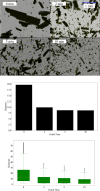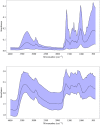Effects of fine grinding on mid-infrared spectroscopic analysis of plant leaf nutrient content
- PMID: 37072478
- PMCID: PMC10113243
- DOI: 10.1038/s41598-023-33558-5
Effects of fine grinding on mid-infrared spectroscopic analysis of plant leaf nutrient content
Abstract
Fourier transform mid infrared (FT-MIR) spectroscopy combined with modeling techniques has been studied as a useful tool for multivariate chemical analysis in agricultural research. A drawback of this method is the sample preparation requirement, in which samples must be dried and fine ground for accurate model calibrations. For research involving large sample sets, this may dramatically increase the time and cost of analysis. This study investigates the effect of fine grinding on model performance using leaf tissue from a variety of crop species. Dried leaf samples (N = 300) from various environmental conditions were obtained with data on 11 nutrients measured using chemical methods. The samples were scanned with attenuated total reflectance (ATR) and diffuse reflectance (DRIFT) FT-MIR techniques. Scanning was repeated after fine grinding for 2, 5, and 10 min. The spectra were analyzed for the 11 nutrients using partial least squares regression with a 75%/25% split for calibration and validation and repeated for 50 iterations. All analytes except for boron, iron, and zinc were well-modeled (average R2 > 0.7), with higher R2 values on ATR spectra. The 5 min level of fine grinding was found to be most optimal considering overall model performance and sample preparation time.
© 2023. The Author(s).
Conflict of interest statement
The authors declare no competing interests.
Figures




References
-
- Candoğan K, Altuntas EG, İğci N. Authentication and quality assessment of meat products by Fourier-transform infrared (FTIR) spectroscopy. Food Eng. Rev. 2021;13:66–91. doi: 10.1007/s12393-020-09251-y. - DOI
-
- Hansen PW, Holroyd SE. Development and application of Fourier transform infrared spectroscopy for detection of milk adulteration in practice. Int. J. Dairy Technol. 2019;72:321–331.
-
- Madurapperumage A, Johnson N, Thavarajah P, Tang L, Thavarajah D. Fourier-transform infrared spectroscopy (FTIR) as a high-throughput phenotyping tool for quantifying protein quality in pulse crops. Plant Phenome J. 2022;5:e20047. doi: 10.1002/ppj2.20047. - DOI
-
- Sharma S, Sarika Bharti A, Singh R, Uttam KN. Non-destructive phenotyping of chili pepper ripening using spectroscopic probes: A potential approach for Shelf-life measurement. Anal. Lett. 2019;52:1590–1613. doi: 10.1080/00032719.2018.1558231. - DOI
MeSH terms
LinkOut - more resources
Full Text Sources
Miscellaneous

